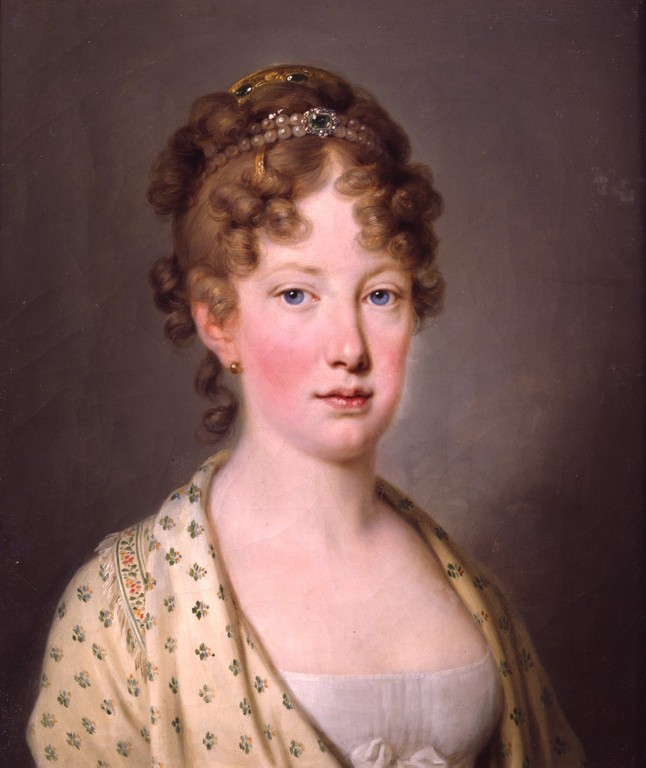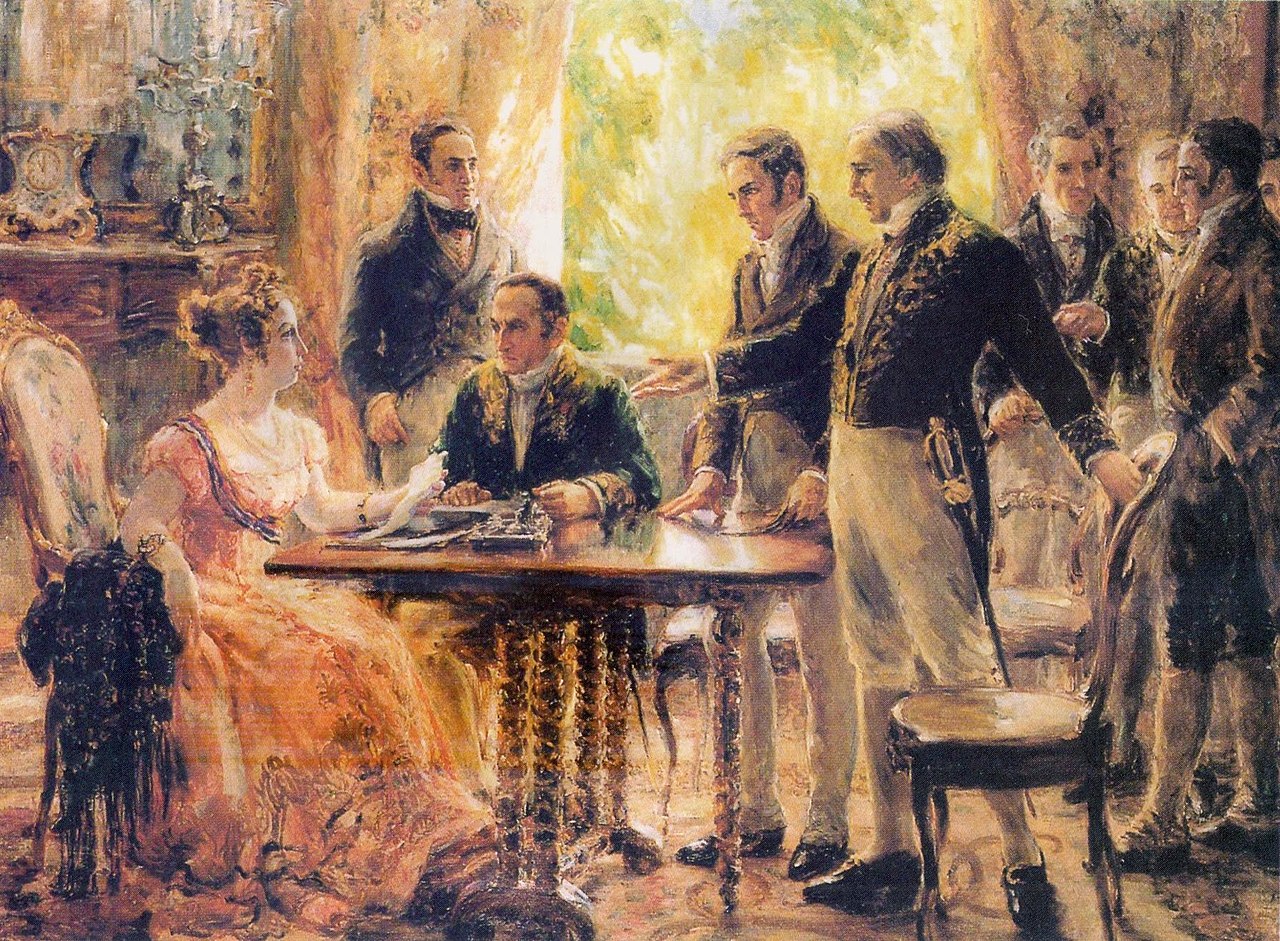by Susan Flantzer
© Unofficial Royalty 2019

Maria Leopoldina of Austria, Empress of Brazil, Queen of Portugal; Credit – Wikipedia
Maria Karoline Josepha Leopoldina Franziska Ferdinanda was born as an Archduchess of Austria on January 22, 1797, at Schönbrunn Palace in Vienna, Austria. Known as Leopoldina, she was fifth of the twelve children and the fourth of the eight daughters of Emperor Franz I of Austria and the second of his four wives, Maria Theresa of Naples and Sicily.
Leopoldina had eleven siblings:
-
- Archduchess Marie- Ludovica (1791 – 1847), married (1) Napoleon Bonaparte; had one son (2) Adam Albert, Count von Neipperg; had three children (3) Charles, Count of Bombelle, no children
- Emperor Ferdinand I (1793 – 1875), married Maria Anna of Savoy; no issue
- Archduchess Marie Karoline (1794 – 1795), died in childhood
- Archduchess Caroline Ludovika (1795 – 1797), died in childhood
- Archduchess Maria Clementina (1798 – 1881), married her maternal uncle Leopold, Prince of Salerno, had one surviving daughter
- Archduke Joseph Franz Leopold (1799 – 1807), died in childhood, no issue
- Archduchess Marie Caroline (1801 – 1832), married Crown Prince (later King) Frederick Augustus II of Saxony, no issue
- Archduke Franz Karl (1802 – 1878), married Princess Sophie of Bavaria; had five children including Emperor Franz Joseph I of Austria and Emperor Maximilian I of Mexico
- Archduchess Maria Anna (1804 – 1858), unmarried, intellectually disabled like her eldest brother, Emperor Ferdinand I
- Archduke Johann Nepomuk (1805 – 1809), died in childhood
- Archduchess Amalie Theresa (born and died 1807)

Franz, Maria Theresa, and their older children, Leopoldina is the youngest daughter in the portrait; Credit – Wikipedia
Leopoldina was educated with her sisters Marie Ludovica, Marie Clementina, and Marie Karoline. As a child Leopoldina was interested in botany, lepidopterology (the study of butterflies), and mineralogy. Leopoldina showed a talent for drawing and some of her pictures are preserved in the picture archive of the Austrian National Library. She was fluent in German, French, Italian, and Latin.
While pregnant with her twelfth child, Leopoldina’s mother Maria Theresa fell ill with the lung infection pleurisy. Her doctor bled her and this caused premature labor. Maria Theresa gave birth to her twelfth child, who lived only one day, and then she died on April 13, 1807, at the age of 34. Leopoldina’s father Franz was inconsolable and had to be forcibly removed from his wife’s body. The death of her mother greatly affected ten-year-old Leopoldina.

Maria Ludovica, Empress of Austria, with three of her stepchildren: Ferdinand, Maria Leopoldina, and Franz Karl; Credit – Wikipedia
Emperor Franz I consoled his grief with visits to his uncle and aunt, Archduke Ferdinand Karl of Austria-Este and Maria Beatrice Ricciarda d’Este, and fell in love with their beautiful and literate daughter and his first cousin Maria Ludovika of Austria-Este who was 19 years old, twenty years younger than Franz. Maria Ludovika and Franz were married on January 6, 1808. Their marriage was childless but Leopoldina dearly loved her stepmother and considered Maria Ludovica to be her “spiritual mother.” Sadly, Maria Ludovica died of tuberculosis just eight years later. Leopoldina’s father married for the fourth time to Caroline Augusta of Bavaria and that marriage was also childless.
Around the time of Maria Ludovica’s death, negotiations began for a marriage between 19-year-old Leopoldina and 18-year-old Pedro, Crown Prince of Portugal and Prince of Brazil. Pedro was the son of King João VI of Portugal and Infanta Carlota Joaquina of Spain, daughter of King Carlos IV of Spain. At that time, Brazil was ruled as a kingdom united with Portugal. In 1807, when Pedro was nine years old, the Portuguese royal family moved to Brazil to escape the Napoleonic invasion and remained in Brazil where Rio de Janeiro became the de facto capital of the Portuguese Empire. Emperor Franz was not a great supporter of this marriage because he knew about the immoral lifestyle and the epilepsy of the proposed groom. At the insistence of Prince Klemens von Metternich, Foreign Minister of the Austrian Empire at that time, later Chancellor, Franz eventually gave his approval to the marriage.

Pedro I, Emperor of Brazil by Simplício Rodrigues de Sá, 1822; Credit – Wikipedia
Leopoldina and Pedro were married by proxy at the Augustinian Church in Vienna on May 13, 1817, with Leopoldina’s uncle, Archduke Karl, Duke of Teschen standing in for the groom. The bride left Vienna on June 3, 1817, and arrived in Livorno, Tuscany (now in Italy) on July 24, 1817, where she was to embark on a three-month voyage to Rio de Janeiro, Brazil. On November 6, 1817, Leopoldina and Pedro were married in person in the chapel of the Paço de São Cristóvão (Saint Christopher’s Palace) in Rio de Janeiro where the couple lived after their marriage. Leopoldina had to adjust to Brazil’s heat and humidity, tropical rainfall, and the ever-present insects.
Leopoldina and Pedro had seven children:
- Maria II, Queen of Portugal (1819 – 1853), married (1) Auguste de Beauharnais, 2nd Duke of Leuchtenberg, died a few months after the marriage (2) Prince Ferdinand of Saxe-Coburg and Gotha (first cousin of Queen Victoria of the United Kingdom and her husband Prince Albert, as well as King Leopold II of Belgium and Empress Carlota of Mexico), had seven sons and four daughters including King Pedro V of Portugal and King Luís I of Portugal
- Miguel, Prince of Beira (born and died 1820)
- João Carlos, Prince of Beira (1821 – 1822), died in infancy
- Princess Januária of Brazil, recognized as an Infanta of Portugal but was later excluded from the Portuguese line of succession after Brazil became independent (1822 – 1901), married Prince Luigi, Count of Aquila, son of Francesco I, King of the Two Sicilies, had three sons and one daughter
- Princess Paula of Brazil, born in Brazil after its independence and was excluded from the Portuguese line of succession (1823 – 1833), died at age 9 of meningitis
- Princess Francisca of Brazil, born in Brazil after its independence and was excluded from the Portuguese line of succession (1824 – 1898), married Prince François of Orléans, son of Louis Philippe I, King of the French, had two daughters and one son
- Pedro II, Emperor of Brazil, born in Brazil after its independence and was excluded from the Portuguese line of succession (1825 – 1891), married Princess Teresa Cristina of the Two Sicilies, daughter of Francesco I, King of the Two Sicilies, had two sons and two daughters

Leopoldina with some of her children by Domenico Failutti; Credit – Wikipedia
In 1821, after a series of revolutions and army mutinies, King João VI, under pressure from the Portuguese parliament, departed Brazil for Portugal, leaving behind Leopoldina and Pedro as Regent. Pedro was quite uneducated and the intelligent and well-educated Leopoldina quickly gained influence over her husband. Pedro discussed all government affairs with her and usually followed her advice. In January 1822, Pedro initiated an autonomous government for Brazil, a decisive step in the history of Brazil, which was definitely due to the influence of Leopoldina. This was done because it was known that Portugal intended to recall Pedro and relegate Brazil to the status of a colony.
In August 1822, Pedro appointed Leopoldina Regent while he went on a political trip to the Province of São Paulo. While Pedro was away, Leopoldina received news that Portugal was about to take action, and without waiting for Pedro’s return, met with the Council of State on September 2, 1822, and signed the Decree of Independence, declaring Brazil independent from Portugal. Pedro I was declared Emperor of Brazil on October 12, 1822, his 24th birthday, and Leopoldina became Empress of Brazil. Pedro’s coronation was held on December 1, 1822, in what is today known as the Old Cathedral of Rio de Janeiro.

Maria Leopoldina acting as regent on behalf of her husband during the September 2, 1822 meeting with the Council of Ministers by Georgina de Albuquerque; Credit – Wikipedia
When Pedro’s father King João VI of Portugal died in March 1826, it caused a succession crisis. Pedro was his eldest living son and heir but he had declared Brazil’s independence and was ruling as Emperor Pedro I of Brazil. King João VI had appointed his daughter Isabel Maria to serve as regent until the “legitimate heir returned to the Kingdom” but he never specified who that should be. Pedro was ruling as Emperor of Brazil, and King João VI’s younger son Miguel (the future King Miguel I of Portugal) had been exiled to Austria after leading several revolutions against his father and his liberal regime. While Pedro was the legitimate heir, the Brazilian people did not want the two thrones to be reunited. Pedro reigned as King of Portugal for only two months and then abdicated the Portuguese throne on May 2, 1826, in favor of his seven-year-old daughter Maria.

Maria Leopoldina, Empress of Brazil by Luís Schlappriz; Credit – Wikipedia
In 1822, Pedro had begun an affair with Brazilian noblewoman Domitila de Castro, Marchioness of Santos. He had mistresses during his marriage to Leopoldina but was always careful to conceal his affairs. This time, Pedro flaunted the affair. He was increasingly rude and disrespectful to Leopoldina, left her short of money, prohibited her from leaving the palace, and forced her to endure his mistress Domitila as her lady-in-waiting.) In November 1826, Leopoldina was pregnant with her eighth child (she had given birth to seven children in six years). Pedro arranged a farewell reception before he left for a military trip. He demanded that his wife and his mistress attend the reception along with government, diplomatic, and church officials. Leopoldina refused to attend, causing a bitter argument with Pedro which remained unresolved when he left on his trip.
Shortly thereafter, 29-year-old Leopoldina died at the Palacio de São Cristovão on December 11, 1826, from puerperal fever (childbed fever) after a miscarriage. She was buried in the Ajuda Convent in Cinelândia Square in the center of Rio de Janeiro. When the convent was demolished in 1911, Leopoldina’s remains were transferred to the Convent of St. Anthony in Rio de Janeiro where a mausoleum was built for her and some other members of the Brazilian Imperial Family. Eventually, Leopoldina’s remains were transferred to the Brazilian Imperial Crypt and Chapel under the Monument of the Ipiranga (Monument to the Independence of Brazil) in São Paulo, Brazil.

Tomb of Maria Leopoldina, Empress of Brazil; Credit – By Photograph by Mike Peel (www.mikepeel.net)., CC BY-SA 4.0, https://commons.wikimedia.org/w/index.php?curid=64026646
This article is the intellectual property of Unofficial Royalty and is NOT TO BE COPIED, EDITED, OR POSTED IN ANY FORM ON ANOTHER WEBSITE under any circumstances. It is permissible to use a link that directs to Unofficial Royalty.
Portugal Resources at Unofficial Royalty
Works Cited
- De.wikipedia.org. (2018). Maria Leopoldine von Österreich. [online] Available at: https://de.wikipedia.org/wiki/Maria_Leopoldine_von_%C3%96sterreich [Accessed 5 Aug. 2018].
- En.wikipedia.org. (2018). Maria Leopoldina of Austria. [online] Available at: https://en.wikipedia.org/wiki/Maria_Leopoldina_of_Austria [Accessed 5 Aug. 2018].
- Flantzer, S. (2016). Franz I, Emperor of Austria. [online] Unofficial Royalty. Available at: https://www.unofficialroyalty.com/franz-i-emperor-of-austria/ [Accessed 5 Aug. 2018].
- Flantzer, S. (2013). Maria Theresa of Naples and Sicily, Empress of Austria. [online] Unofficial Royalty. Available at: https://www.unofficialroyalty.com/june-6-daily-featured-royal-date/ [Accessed 5 Aug. 2018].
- Mehl, S. (2016). Queen Maria II of Portugal. [online] Unofficial Royalty. Available at: https://www.unofficialroyalty.com/queen-maria-ii-of-portugal/ [Accessed 5 Aug. 2018].
- Pt.wikipedia.org. (2018). Maria Leopoldina de Áustria. [online] Available at: https://pt.wikipedia.org/wiki/Maria_Leopoldina_de_%C3%81ustria [Accessed 5 Aug. 2018].
